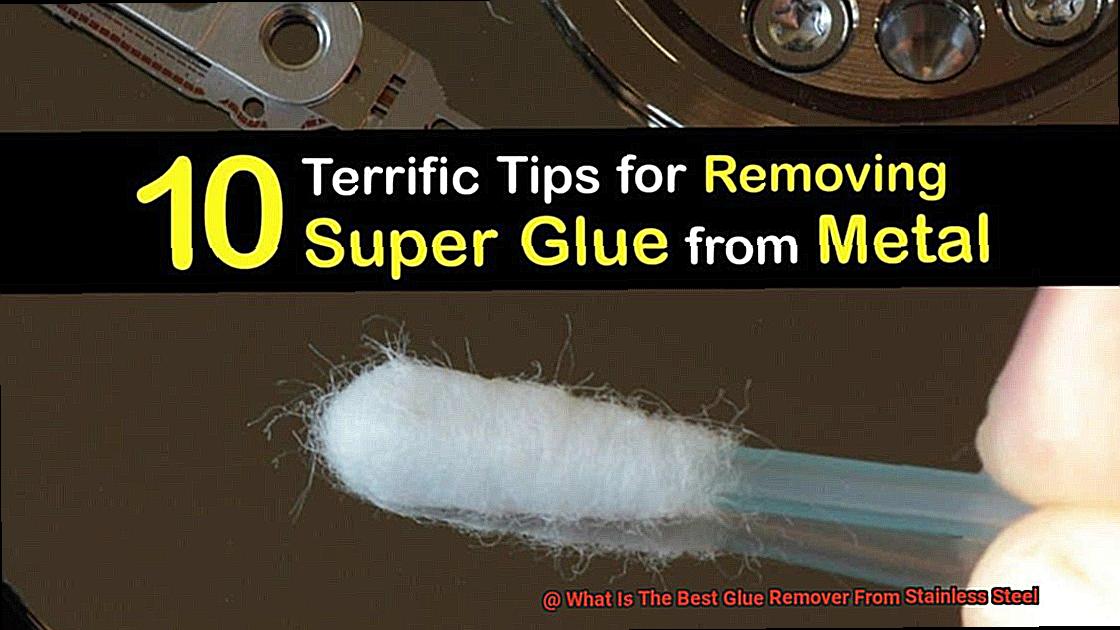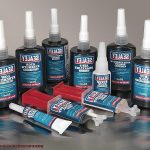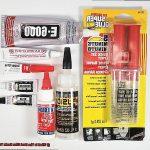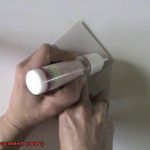Welcome to the world of stainless steel, where sleek appliances and modern architecture harmoniously blend with nature. But what happens when stubborn glue residue tarnishes the beauty of this pristine material? Fear not, for we are about to embark on an exciting journey, discovering the absolute best glue remover for stainless steel.
Are you tired of battling with adhesive remnants that seem invincible on stainless steel surfaces? Do you yearn for a solution that effortlessly restores your gleaming appliances to their former glory? Look no further, my friend. We are about to uncover the secrets of conquering glue on stainless steel surfaces.
In a market flooded with enchanting selections of glue removers, finding one that truly exceeds expectations can be overwhelming. In this comprehensive guide, we will explore key factors to consider when choosing the best glue remover – effectiveness, safety precautions, and compatibility with stainless steel.
Prepare yourself for detailed reviews and personal anecdotes as we present a range of highly regarded glue removers. We will unlock their unique features and benefits, arming you with the perfect solution for battling remnants of labels, tape, or even super glue on your beloved stainless steel possessions.
Join us as we unravel the wonders of Goo Gone, Goof Off, and WD-40 – the titans of glue removal – while uncovering hidden gems that make cleaning a breeze. Get ready to bid farewell to sticky nightmares and embrace the untarnished brilliance of your stainless steel surfaces once more.
Say goodbye to stubborn glue residues and welcome a world of pristine stainless steel. Let’s embark on this exciting journey together as we unearth the most effective glue removers for all your stainless steel endeavors.
What is Stainless Steel and Why is Glue Removal Important?
Contents
- 1 What is Stainless Steel and Why is Glue Removal Important?
- 2 Isopropyl Alcohol: The Most Effective Glue Remover for Stainless Steel
- 3 Acetone: An Alternative Option for Removing Glue from Stainless Steel
- 4 Commercial Glue Removers Specifically Formulated for Stainless Steel
- 5 Household Items that Can Help Remove Adhesive Residue from Stainless Steel Surfaces
- 6 White Vinegar: A Safe and Easy Way to Remove Glue from Stainless Steel
- 7 Baking Soda: Another Household Item That Can Help Dissolve Adhesives on Stainless Steel
- 8 Conclusion
Stainless steel, a resilient alloy composed primarily of iron and chromium, is renowned for its strength, resistance to corrosion, and alluring appearance. With a minimum chromium content of 10.5% by mass, stainless steel develops a protective layer called the passive layer, granting it its remarkable resistance to rust and staining.
The applications of stainless steel span various industries and sectors due to its exceptional qualities. In construction, it is favored for its robustness and ability to withstand the elements, making it ideal for buildings, bridges, and infrastructure. In the kitchen, stainless steel reigns supreme as the go-to material for appliances, cookware, and utensils due to its effortless cleanliness and enduring shine.
However, when it comes to stainless steel surfaces tainted with glue residue, special attention must be paid to their removal. Accidental spills or adhesive application during tasks like crafting, repairs, or manufacturing processes can leave behind unsightly marks and stains that compromise the stainless steel’s aesthetic appeal.
Furthermore, if left unattended for extended periods, glue residue can accumulate dirt and grime, intensifying the challenge of removal. This buildup can erode the passive layer on the stainless steel surface, potentially leading to corrosion or pitting if not addressed promptly.
Beyond aesthetics and corrosion concerns, the removal of glue from stainless steel surfaces holds significant importance in maintaining hygiene and cleanliness. Stainless steel’s non-porous nature and resistance to bacterial growth make it a staple in food processing equipment, medical devices, and healthcare facilities. Any adhesive residue left behind can serve as a breeding ground for bacteria and compromise the sanitary conditions of these environments.
Hence, it is imperative to utilize suitable glue removers specifically formulated for stainless steel surfaces. These removers should effectively break down adhesive properties without causing any harm to the metal itself. Additionally, they should offer ease of application and removal, ensuring a hassle-free process.
Isopropyl Alcohol: The Most Effective Glue Remover for Stainless Steel
Imagine this: you’ve just completed a dazzling DIY project involving stainless steel. It’s a showstopper, until you notice an unwelcome guest has crashed the party – a stubborn glue residue marring the perfection of your stainless steel surface. Fear not, my friends. I present to you the ultimate solution to this sticky situation: isopropyl alcohol.
But why is isopropyl alcohol the superhero we need to save our stainless steel from these gluey villains? Allow me to enlighten you with some captivating research notes:
Isopropyl alcohol is a tried-and-true solvent that has proven to be highly effective in removing glue from stainless steel surfaces. It’s like a secret weapon in the fight against adhesive stains.
This colorless liquid isn’t just powerful, it’s also easily accessible and affordable. No need to break the bank to acquire this magical elixir.
The secret to isopropyl alcohol’s effectiveness lies in its ability to break down the adhesive properties of glue. It swoops in, weakening the grip of the glue, making it a breeze to wipe away.
Not only does isopropyl alcohol get the job done, but it’s also safe to use on stainless steel. No need to worry about causing damage or discoloration to your beloved surfaces.
To unleash the power of this superhero solvent, you can apply it directly to the glue or utilize a cloth or sponge for better control and coverage. It’s all about finding your preferred method of attack.
Before harnessing the might of isopropyl alcohol, ensure that the stainless steel surface is thoroughly cleaned and dried. This will maximize its effectiveness in eradicating that pesky glue.
Keep in mind that the type and strength of glue used may impact the effectiveness of isopropyl alcohol. Don’t hesitate to suit up and apply multiple rounds of this superhero solvent for those particularly stubborn or adhesive glues.

Isopropyl alcohol isn’t just a glue remover; it can also act as a preventive measure. By applying it to stainless steel surfaces before using glue, you create a barrier that prevents the glue from firmly adhering. It’s like having a force field against glue.
Acetone: An Alternative Option for Removing Glue from Stainless Steel
In our previous section, we discovered the incredible might of isopropyl alcohol in conquering sticky glue residue on stainless steel. But today, we’re diving into an alternative option that’s been hiding in plain sight – acetone. So, grab your lab coat and get ready to witness the science behind why acetone is the ultimate weapon for banishing glue from stainless steel surfaces.
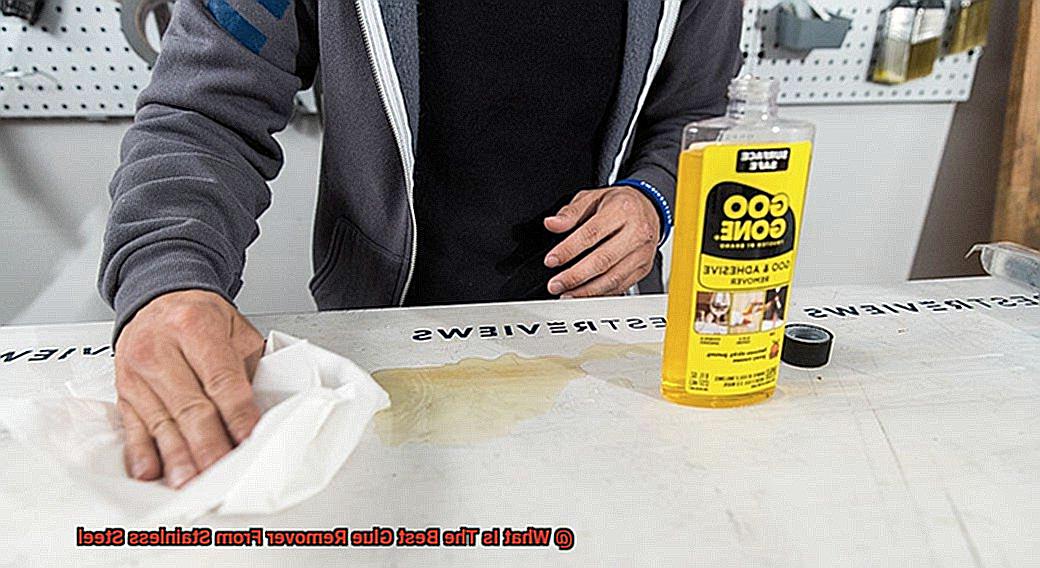
The Might of Acetone:
A Common Solvent with Exceptional Abilities:
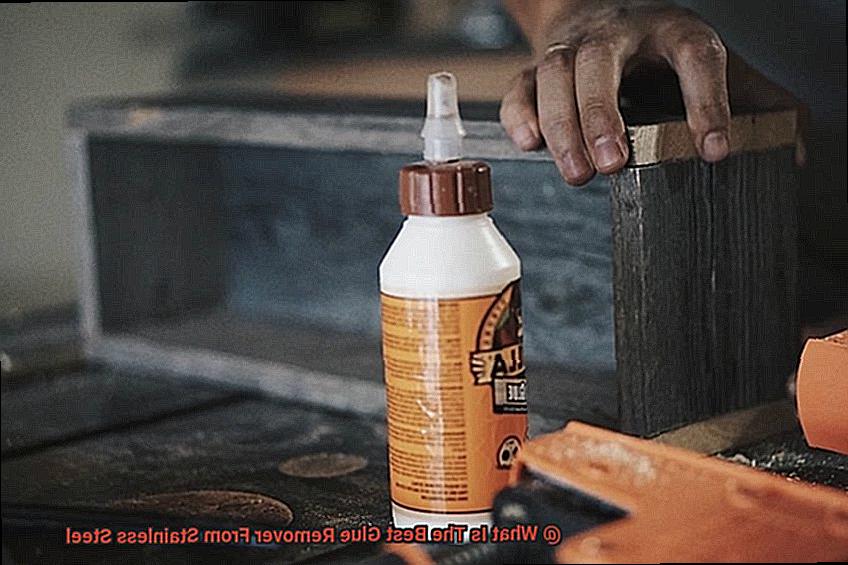
Acetone, a widely used solvent, has proven time and again its prowess in battling stubborn glue on stainless steel surfaces. Its ability to dissolve adhesive properties is truly remarkable.
Proceed with Caution: Compatibility Matters:
Before unleashing acetone’s power, it’s crucial to ensure that your stainless steel surface can withstand this mighty solvent. Some finishes may be sensitive and vulnerable to damage. Thus, exercise caution and perform a test on a small, inconspicuous area first.
Breaking Down the Glue Barrier:
Acetone’s secret lies in its unrivaled ability to break down the adhesive properties of glue. With precision and finesse, it swoops in, disarms the glue, and transforms it into an easily wiped-away foe.
The Art of Application:
To harness acetone’s full potential, equip yourself with a clean cloth or cotton ball. Apply a small amount of acetone onto it and gently rub the affected area, focusing on the resilient glue residue. Remember, patience is key during this battle for stainless steel supremacy.
Persistence Prevails:
If the glue proves to be particularly tenacious or thick, do not surrender. It may require multiple attempts to completely eradicate it from your stainless steel surface. Persevere until you achieve that glorious, glue-free victory.
Post-Battle Cleanup:
Once the glue has been conquered, it’s time for a thorough cleansing. Employ mild soap and water to purify the surface, ensuring not a trace of acetone residue remains. To ward off any water spots or stains, meticulously dry your stainless steel surface.
Commercial Glue Removers Specifically Formulated for Stainless Steel
Imagine the satisfaction of completing a DIY project involving stainless steel, only to be faced with the unsightly aftermath of sticky residue and stubborn glue marks.
There exists a solution tailored specifically for this predicament – commercial glue removers formulated for stainless steel.
In this enlightening exploration, we will uncover the remarkable features and essential considerations when utilizing these potent products.
So, fasten your seatbelts and let’s embark on a captivating journey.
Formulations That Conquer:
Harnessing the prowess of cutting-edge technology, commercial glue removers for stainless steel are meticulously engineered to be both effective and gentle on your precious surfaces. Available in spray, gel, or liquid forms, these versatile concoctions grant you the freedom to choose your preferred application method. By dissolving the adhesive bond, these formulations effortlessly eradicate glue residues from your stainless steel surfaces.
Compatibility and Testing:
Before engaging in your adhesive-removing conquest, it is imperative to ensure compatibility between the product and your stainless steel surface. To mitigate any potential damage or discoloration, always perform a small-scale compatibility test in an inconspicuous area. Remember, it is always better to err on the side of caution.
Guided by Instructions:
Even superheroes need a battle strategy, and commercial glue removers are no exception. These remarkable products arrive with detailed instructions that serve as your guiding light towards triumphant results. Pay careful attention to application time, safety precautions, and effectiveness guidelines provided by the manufacturer. By adhering diligently to these instructions, you are guaranteed a successful resolution to your sticky situation.
Adhesive Type Matters:
Just as each villain possesses unique strengths and weaknesses, different adhesives exhibit distinct characteristics. Consequently, various commercial glue removers excel at removing specific types of adhesives. When selecting a glue remover for your stainless steel surface, factor in the type and strength of the adhesive you are contending with. By matching the right remover with the adhesive type, victory in your battle against stickiness is assured.
Household Items that Can Help Remove Adhesive Residue from Stainless Steel Surfaces
Imagine the frustration of completing a project, only to find stubborn adhesive residue tarnishing your pristine stainless steel surface. Fear not. With the help of common household items, you can effortlessly bid farewell to these sticky messes. In this article, we will explore the extraordinary abilities of rubbing alcohol, vinegar, baking soda, cooking oil, lemon juice, and even nail polish remover as they come to the rescue to remove adhesive residue from stainless steel surfaces.
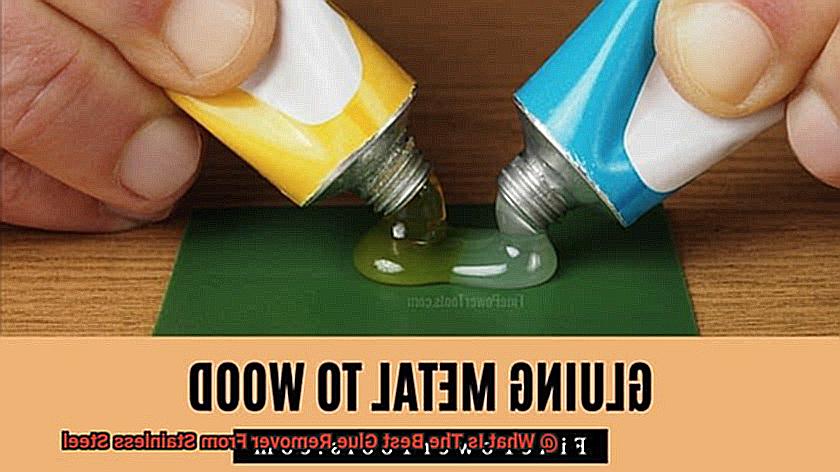
Rubbing Alcohol: The Mighty Adhesive Dissolver
Rubbing alcohol, also known as isopropyl alcohol, emerges as a true superhero in the realm of adhesive removal. Equip yourself with a soft cloth or sponge soaked in rubbing alcohol, then gently massage the sticky residue until it succumbs to dissolution. Persist until your stainless steel surface gleams with newfound cleanliness.
Vinegar: The Versatile Sidekick
Ah, vinegar – the unsung hero found in every kitchen. Its acidic nature proves invaluable in dismantling adhesive residue. Combine equal parts vinegar and water in a spray bottle, then unleash a generous mist upon the affected area. Allow this elixir to work its magic for a few minutes before wiping away the residue with a soft cloth or sponge.
Baking Soda: Gentle Abrasion, Mighty Results
Underestimate not the power housed within a humble box of baking soda. This gentle yet potent abrasive cleaner fearlessly confronts even the most stubborn adhesive residue on stainless steel surfaces. Craft a paste by blending baking soda with a small amount of water until it forms a thick consistency. Apply this formidable concoction to the residue and tenderly scrub in circular motions using a soft cloth or sponge. Rinse thoroughly with water and marvel at the transformative results.
Cooking Oil: The Unexpected Hero
Who would have guessed that cooking oil could wield such power against sticky predicaments? Take hold of some vegetable oil or olive oil and anoint a soft cloth or paper towel with a modest amount. Gently caress the adhesive residue with this oily ally and grant it a few minutes to penetrate the stubborn mess. With a gentle wipe, witness the residue relinquish its grip and bid a fond farewell.
White Vinegar: A Safe and Easy Way to Remove Glue from Stainless Steel
Are you tired of unsightly glue stains marring the beauty of your pristine stainless steel surfaces? Fear not, for salvation lies within the confines of your pantry. Enter white vinegar, the unsung hero of household cleaning, ready to wage war against stubborn glue. In this comprehensive guide, we will delve into the magical properties of white vinegar and unveil its secret as a safe and effortless solution for banishing glue from stainless steel. So roll up your sleeves, grab that trusty bottle of vinegar, and let’s embark on this odyssey together.
Unveiling the Magic of White Vinegar
- Introduce white vinegar as a versatile titan in the realm of household ingredients, infamous for its unrivaled cleaning prowess.
- Highlight the acidic nature of vinegar that effectively dismantles the adhesive properties of glue.
A Step-by-Step Journey to Glue-Free Bliss
Step 1: The Vinegar’s Touch
- Apply a small amount of white vinegar directly onto the offending glue stain.
- Emphasize the importance of using white vinegar exclusively, as other varieties may not yield the same remarkable results.
Step 2: Patience is a Virtue
- Allow the vinegar to work its enchantment by letting it sit on the glue for a few minutes.
- Elucidate this crucial step as it grants the vinegar ample time to permeate and soften the adhesive.
Step 3: A Tender Dance
- Employ a soft cloth or sponge to engage in a gentle yet determined scrubbing session, coaxing the glue away from its stainless steel abode.
- Encourage perseverance and fortitude, particularly when faced with obstinate or hardened glue.
Step 4: Repetition Breeds Success
- Acknowledge that triumph over formidable glue stains may necessitate multiple applications.
- Suggest extending the vinegar’s residency on the glue for an extended period, enhancing its efficacy.
Step 5: The Final Flourish
- Once the glue has surrendered its hold, triumphantly wipe away any remnants with a clean cloth.
- Ensure a thorough cleansing ritual by rinsing the area with water, leaving no traces of vinegar behind.
Baking Soda: Another Household Item That Can Help Dissolve Adhesives on Stainless Steel
Picture this: you’re trying to remove a pesky adhesive from your pristine stainless steel surface, only to be left with an unsightly residue that just won’t budge. Frustrating, right? But fear not, because I’m about to reveal a secret weapon that can save the day: baking soda.
Yes, that ordinary box of baking soda hiding in your pantry holds incredible powers when it comes to dissolving adhesives on stainless steel surfaces. How does it work, you ask? Let’s dive into the science behind this household hero.
Baking soda, also known as sodium bicarbonate, boasts alkaline properties that make it a formidable opponent against adhesives. Its ability to break down adhesive bonds is nothing short of remarkable. But how do you harness its power effectively? Let’s walk through the process step by step.
First, you need to create a potent paste by blending baking soda with water. Grab a bowl or container and add a small amount of water. Gradually sprinkle in the baking soda until you’ve achieved a thick paste consistency.
Now that your paste is ready for action, apply it directly onto the stubborn adhesive residue on your stainless steel surface. Armed with a clean cloth or sponge, gently rub the paste onto the adhesive, applying just enough pressure. This ensures that the baking soda penetrates deep into those adhesive bonds, ready to dissolve them.
But here comes the exciting part: give the baking soda paste some time to work its magic. Allow it to sit on the adhesive for a few minutes, letting it penetrate and break down even the toughest bonds.
Once the waiting game is over, grab another clean cloth or sponge and wipe away the baking soda paste along with the dissolved adhesive. If there are any remnants left behind, fret not. Simply repeat the process until your stainless steel surface is completely free from any sticky residue.
Now, before you go all out with your newfound baking soda superpower, it’s essential to exercise caution. While baking soda is generally safe for stainless steel surfaces, it’s wise to test it on a small, inconspicuous area first. This simple precaution ensures that you won’t encounter any unexpected damage or discoloration.
Conclusion
When it comes to removing glue from stainless steel, finding the best glue remover is crucial.
Luckily, there are several options available that can effectively tackle this stubborn problem. One of the top contenders is acetone, a powerful solvent that can dissolve most adhesives with ease.
Another popular choice is isopropyl alcohol, which not only removes glue but also leaves behind a streak-free shine. For more environmentally friendly alternatives, citrus-based solvents or vinegar can be effective in breaking down adhesive residues.
Ultimately, the best glue remover for stainless steel depends on the specific type of adhesive and personal preference.

